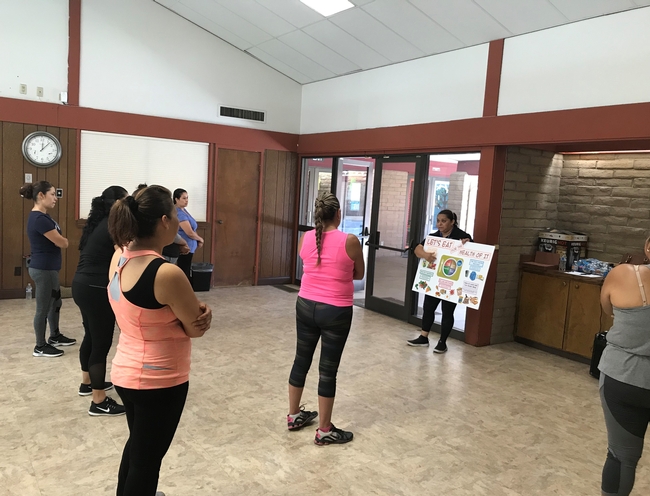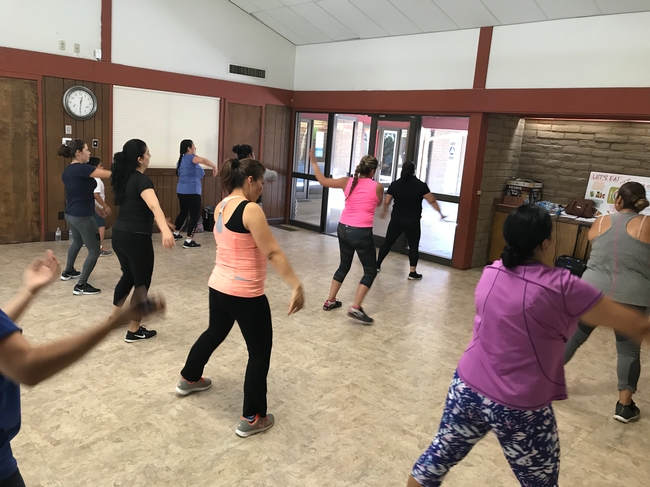A ten month pilot program in Kings County addressed the obesity crisis among parents of young children through nutrition education and Bailoterapia Dance Exercise.
The Issue
Many rural communities in California are finding inspiring solutions to the obesity crisis by leveraging local community strengths to promote healthy living. Kings County in California is largely a rural county with 80% of SNAP-Ed adults overweight or obese. The Corcoran Family Resource Center (FRC) located in Kings County identified a need to improve nutrition education and physical activity awareness among the parents of young children.
How UC Delivers
This need stimulated the CalFresh Healthy Living-UC program (CFHL, UC) to collaborate with Corcoran FRC and Family Healthcare Network (FHCN) to develop and initiate a 10-month pilot to address this obesity issue by providing weekly spotlight nutrition education and Bailoterapia dance exercise lessons to adults and parents of young children. This pilot initiative concluded in April 2019. The CFHL, UC program implemented the nutrition and dance exercise classes and identified a promotora, community champion, to sustain the dance classes at the Corcoran FRC site. FHCN supported the promotora's liability responsibility and conducted free health screenings. Corcoran FRC provided access to the site for physical activity classes and childcare while parents attended dance classes. Participants' goals and intentions were measured using intent-to-change surveys on a variety of healthy eating and active living topics: food groups, breakfast, sweetened beverages, fruits, vegetables, dairy, grains, portion size, fast food, and physical activity. Additionally, CFHL, UC administered and piloted the pre-post Adult Physical Activity Survey (APAS) with 8 adult participants to evaluate physical activity (PA) behaviors. Moreover, at the conclusion of the pilot, two focus groups were conducted with dance exercise participants (n=13) and key community partners (n=7). All program participants were female, predominantly Spanish speaking, and primary caregivers of young children. The Social-Ecological Model and SNAP-Ed Evaluation Framework were utilized to design the research and tailor evaluation questions for the various levels of anticipated outcomes at the individual and environmental levels.

The Impact
Of the 141 intent-to-change surveys completed, 83% of participants not already practicing the promoted behavior indicated their intention to do so within the next week. The APAS pilot findings were very promising with increases from pre to post in Bailoterapia participants meeting the PA guidelines for moderate to vigorous physical activity (MVPA) (25% point gain) and muscle strengthening (38% point gain). Additionally, the majority of the Bailoterapia participants reported improvements from pre to post in the number of days they exercised for 30 or more minutes (50%; ½ a day more) and built or strengthened muscles (63%; 1¼ days more), as well as the frequency of making small changes to be more active (63%; gaining 1.13 on a 5-point scale, p<.05). Due to the small sample only one statistically significant result was observed.
The focus group findings of the participants and community partners highlighted program effectiveness and benefits. These included improvements in participant's knowledge, skills, attitude, and behavior about nutrition and physical activity. One participant shared the benefits of participating in the program: “I also suffer with anxiety, and going [to this program] I have fun dancing, I enjoy it, I sweat, and it makes me feel like I have a lot of energy. And I've also kept an adequate weight and nutrition.”
For community partners, program success was attributed to organizational capacity, expertise, and funding; program monitoring and evaluation; free childcare and health screenings; and being sensitive to participants' cultural-social norms and values. The UCCE Nutrition Educator shared, “As a consequence [of the nutrition and exercise weekly classes], the ladies look forward to Fridays. One of the ladies said, 'I didn't come last Friday, and it threw my whole week off.' So, that's how much it's on their mind now that they're expecting -- looking forward to -- that day of physical activity.”
Overall, program effectiveness and benefits included community partnerships coming together to sustain health promotion efforts and participants and their families adopting healthier lifestyles. For example, one participant mentioned, “[M]y husband was suffering with high cholesterol, so when I started coming to the classes, it was a way to communicate to him how he should help himself. And during that time, he started to change his nutrition. He lowered his cholesterol numbers a lot. So, when he went back to his new appointment with his doctor, the doctor was surprised [at] what he had done to lower his cholesterol so much.”
Through its strong community partnerships, UC ANR improved community health and wellness in Kings County, contributing to the public value of promoting healthy people and communities.
Attached Images:
